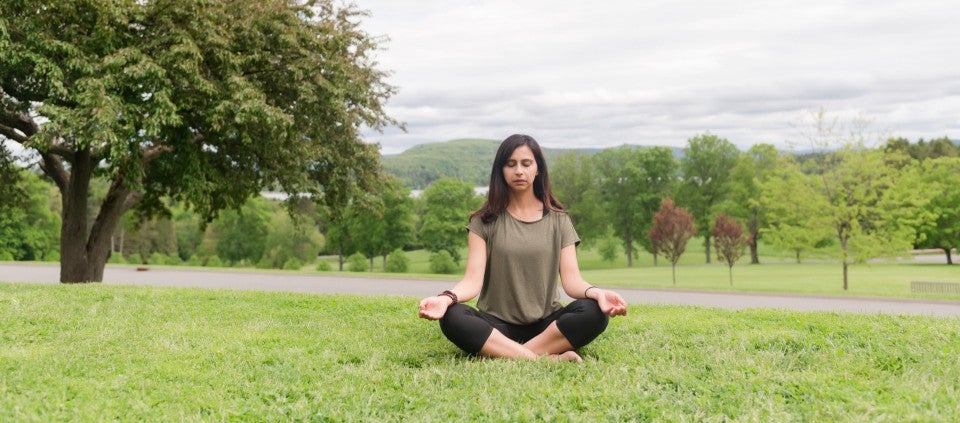Resilience: Practices for Bouncing Back from Disappointment, Difficulty, and Disaster

March 24, 2020
Resilience is always needed, especially during times when it’s easy to be scared and wise to be concerned. Resilience—the capacity to deal with any stress and bounce back from any adversity—is as necessary to our well-being as the new virus is disruptive to it.
Resilience really means our learned capacities to cope with anything, anything at all.
We can cope with disappointment now, as we all are, when restaurants and bars are closed, trips are cancelled, sporting events and cultural events are postponed, and programs at Kripalu and other venues are rescheduled.
We can cope with difficulty now, as we all are, when schools, daycare centers, and libraries close and colleges shift to online learning. And when so many closures threaten the livelihood of almost everyone we know.
We can cope even with disaster, as many of us are now, in the face of illness.
And we cope with so much unknown, so much uncertainty.
Things to Remember About Resilience
1. Skills and strategies of resilience are learnable and trainable.
Every human brain learns from experience. We learn resilience from the experiences of dealing with hard stuff, and learning that we can. The neuroplasticity innate in every human brain ensures that we can learn and change and grow even from—especially from—experiences of adversity. That’s our birthright as human beings.
“Based upon everything we know about the brain in neuroscience, change is not only possible, but is actually the rule rather than the exception. And because we have a choice about what experiences we want to use to shape our brain, we have a responsibility to choose the experiences that will shape the brain toward the wise and the wholesome.”
—Richard J. Davidson, PhD, founder-director, Center for Investigating Healthy Minds, University of Wisconsin-Madison
2. The core of resilience is response flexibility. People who are resilient tend to be flexible—flexible in the way they think about challenges and flexible in the way they react emotionally to stress. And that is true for any stressor, for any level of disruption.
“How you respond to the issue … is the issue.”
—Frankie Perez, psychologist
3. Choosing how we respond is essential to resilience. We strengthen our resilience by repeatedly practicing the tools and techniques that will install new behaviors, new patterns of response in our neural circuitry, so that we can choose to cope in ways that are skillful and effective. Over time, these new patterns help us develop a resilience mindset. We expect to be able to meet any difficulty, any disaster, because we have learned that we can.
“Mishaps are like knives, that either cut us or serve us, as we grasp them by the blade or the handle.”
—James Russell Lowell
Using the Wisdom of the Body to Recover Our Resilience
The following tools and techniques are ones I teach in my Kripalu program, Bouncing Back from Disappointment, Difficulty, and Even Disaster: The Resilience Mindset. They will be immediately helpful to you now and, practiced over time, can become a resilient way of being.
Our first responses to any stressor—our most basic responses to all of life’s challenges and adversities—begin in our bodies. Mindful awareness helps us be conscious of signals of stress or distress in our bodies, and we can practice tools that will return the body’s nervous system back to its natural baseline equilibrium, what’s called the range of resilience.
3 Breath Practices for Enhancing Resilience
We learn tools of breath first, because we breathe all the time. The breath is always available, as long as we are alive. Breathing happens automatically; we don’t have to remember to do it.
Breathing is what regulates the autonomic nervous system: slight activation of the sympathetic, or mobilizing, branch when we breathe in (a lot when we overreact to something and hyperventilate); and slight activation of the parasympathetic, or calming, branch when we breathe out (a lot when you are very scared and you literally faint). We can learn to very intentionally use the rhythm of breath to cultivate more calm in the body and access a deeper well-being.
1. Conscious Breathing
You know how to do this already. Breathe naturally, gently, for five to 10 breaths. As you begin to breathe more calmly, slowly, gently, and deeply, this takes about one minute. Mindfully pay attention to the sensations of breathing in (cool air through the nostrils or throat, the gentle expansion of the belly and chest) and breathing out with a longer exhale (warmer air flowing out, the relaxation of the belly and chest). Especially as you begin this practice, pause and repeat many times throughout the day.
When you are doing “nothing” but breathing and paying attention to your breathing, you are doing “something” helpful in calming your nervous system and training your nervous system to come to calm. You are learning to chooseto do something that can reliably regulate your nervous system.
2. Box Breath
We know that the startle response is hardwired into our nervous system by evolution, so that when our nervous system perceives danger, we automatically blink to protect our eyes, crouch to protect our bodies, and put both hands up to protect or fight. We can’t retrain the brain to not have that happen—like a sneeze, it’s going to happen. What trainers of fireman and police have discovered is that first responders can be trained to use that startle response as a cue to practice resilience, and the practice they suggest is box breathing. This breath regulates the nervous system back into a state of being calm and relaxed, yet engaged and alert.
To practice, inhale to a count of four, hold the breath for a count of four, exhale to a count of four, and hold out the breath for a count of four. The focused attention on the counting requires your higher brain to stay online, and keeping your higher brain online when you’re startled is key to being able to discern and choose what action to take.
So when you notice your nervous system is so revved up—you’re frightened or panicked or angry or enraged, you’re not thinking straight, the Box Breath can help you come back to your inner equilibrium and activate your brain so you can reengage with what’s happening and decide what action you might need to take.
3. Sigh
You can extend the practice of using the breath to regulate your nervous system by giving yourself permission to sigh. Breathe in fully, then exhale fully, sometimes accompanied by a sound—ahhh—releasing tension from your body. A deep sigh (or several sighs) is the body’s natural re-setter of the nervous system, even in a tense moment—especially in a tense moment.
You can practice pairing any moment of tension with a deliberate sigh. In the midst of a tense or frightening moment, a deliberate sigh can shift the physiology of the body-brain into a more relieved and relaxed state.
The Power of Touch to Restore Calm
Touch is one of the fastest ways we have to both calm down and reenergize the nervous system and restore a sense of safety, according to Dacher Keltner, founder of the Greater Good Science Center at UC Berkeley. Warm, safe touch releases oxytocin, the hormone of safety and trust, of calm and connect. Oxytocin is released by the HPA axis, as is the stress hormone cortisol, and is the brain’s direct and immediate antidote to cortisol.
Even in this time of practicing self-sequestering, we can focus our attention on warm, safe touch to help manage anxiety and distress, and evoke a sense of feeling safe and cared about to deepen calm.
Read Part 2 of this series:
Hand on the Heart Practice
This exercise is one of the most powerful tools we have to restore a sense of calm and equilibrium in the body-brain. Anchored in both mindfulness and self-compassion, it is powerful enough to calm down a panic attack in less than a minute. It’s powerful enough to prevent the stress response from even happening in the first place.
- Place your hand on your heart. Breathe gently, softly, and deeply into the area of your heart. If you wish, breathe in a sense of ease or safety or goodness into this heart center.
- Remember one moment, just one moment when you felt safe, loved, and cherished by another human being. Don’t try to recall the entire relationship, just one moment. This could be a partner, a child, a friend, a therapist, or a teacher; it could be a spiritual figure. Remembering a loving moment with a pet can work very well, too.
- As you remember this moment of feeling safe, loved, and cherished, let yourself experience the feelings of that moment. Let the sensations wash through your body. Let yourself stay with these feelings for 20–30 seconds. Notice any deepening in a visceral sense of ease and safety.
When you breathe deeply into the heart center, you’re activating the calming parasympathetic branch of the nervous system. When you breathe in a sense of ease or safety or goodness, you’re restoring a coherent heart rate variability, which allows you to respond more flexibly to stress. When you remember a moment of feeling safe and cherished, you’re activating the release of oxytocin. You may actually feel the warm glow of the oxytocin as it washes through your body, bringing you to a place of safety, trust, and calm.
Repeat this practice many times a day at first to strengthen the neural circuitry that remembers this pattern. If you practice five times a day for a full week, you will train your brain in this new response to any difficult moment. Then you can repeat it any time you need to, any time at all. Use it in moments of stress or distress. It’s portable equilibrium.
4 Movement Practices for Shifting Emotions
Any time you move your body and shift your posture, you shift your physiology. Any time you shift your physiology, you change the activity and state of your autonomic nervous system. You can intentionally use movement to shift your emotions and your mood. Here are four ways to use movement in this way.
1. Bring your awareness to your hands, and slowly tense your hands into fists. Then release the tension as you open your palms. Do that tensing-releasing a couple of times. Notice any shifting of your inner state.
2. This juxtaposition of tension-relaxation is the basis of progressive muscle relaxation: Tense a muscle group, counting up to seven. Then relax that muscle group, counting to 15. Relaxing twice as long as tensing helps the body relax, a wonderful tool to use when going to sleep at night. The counting, as with the Box Breath, helps the higher brain stay online—this time for the purpose of keeping attention focused on the task, so the brain doesn’t go into rumination or obsessive looping.
3. Place a pencil between your nose and upper lip; this makes you frown a little. Then place the pencil between your teeth; that makes you smile a bit. When you practice this sequence slowly enough, you can notice a change in the state of your body and emotions. Neuroscientists have found that smilingfor even 20 seconds shifts the functioning of the brain.
4. You may already be familiar with the technique of power posing, used to shift the state of the body-brain from one of anxiety or tension to strength and calm. Amy Cuddy’s TED Talk on power posing is the second most-watched talk in the history of TED.
To begin: Stand tall and erect with feet planted firmly on the ground, hip-width apart. Lift your spine, lift your chest, lift your head, and stretch your arms high over your head, as you would in Mountain pose. Stay grounded in your feet, hips, and torso, but feel the energy move up your spine, through your arms and the crown of your head toward the sky. Getting the energy moving up the spine is the most important part of the pose.
You can use power posing in any situation that evokes feelings of anxiety, fear, or shame. If you’re entering a challenging situation, such as a job interview, practice your power pose for a few moments, and then walk mindfully into that situation with more inner strength and energy.
- Allow yourself to feel the anxiety or worry in your body that you want to shift. Then move into the power pose. Stand in Mountain pose: tall and erect, feet about hip-width apart, chest lifted and head held high, arms held high over your head.
- Let yourself feel strength and energy in your body. Experiment with different poses to learn what allows you to experience these feelings most reliably.
- Move back and forth between the posture of anxiety or worry and the posture of the power pose for about five minutes. Gradually let go of the posture of worry and remain in the posture of power, strength, and courage.
With frequent practice, your power pose becomes a natural way to develop and tap into your inner strength, courage, and resilience.
These tools are the beginning steps in recovering your resilience. Many more tools (130+) are available in Resilience: Powerful Practices for Bouncing Back from Disappointment, Difficulty, and Even Disaster and as audio recordings at lindagraham-mft.net.
Practice these tools to cultivate your resilience mindset—during this challenging time, and any time at all.
“I am no longer afraid of storms, for I am learning how to sail my ship.”
—Louisa May Alcott
Linda Graham, MFT, is a psychotherapist, mindful self-compassion teacher, and author of Bouncing Back: Rewiring Your Brain for Maximum Resilience and Well-Being.
Full Bio and Programs
